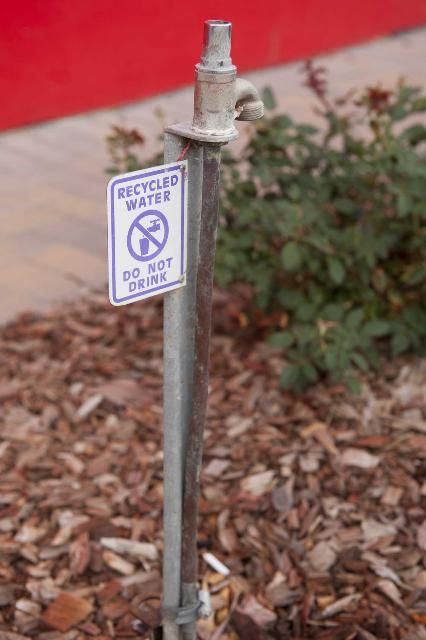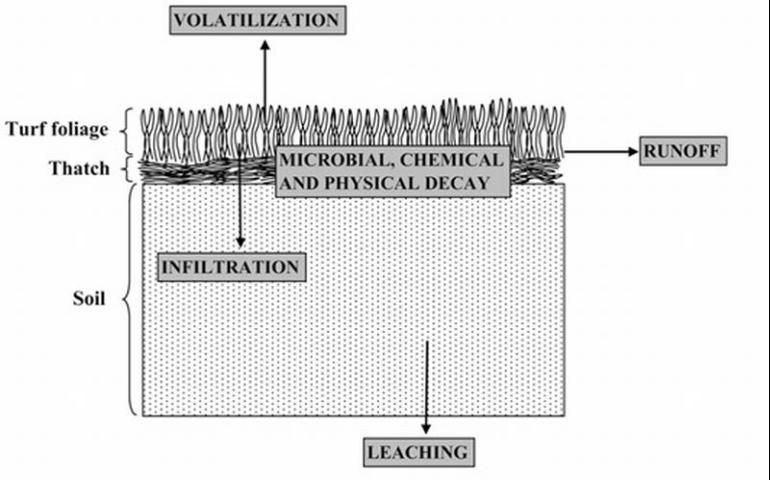This fact sheet is one of a series titled Reclaimed Water Use in the Landscape addressing various issues related to use and management of reclaimed water in urban landscapes.
Introduction and Purpose

Credit: CTRPhotos/iStock/Thinkstock, © CTRPhotos
Reclaimed water is former wastewater from households, schools, offices, hospitals, and commercial and industrial facilities that has been disinfected and treated to remove certain impurities such as nutrients and pathogens. After flowing out of wastewater treatment plants, reclaimed water is piped back to communities for reuse in numerous domestic, industrial, and agricultural applications. Though reclaimed water cannot be used for drinking water in Florida, it is considered highly safe and reliable for non-potable water needs, including:
-
Landscape irrigation
-
Agricultural irrigation, including irrigation of food crops
-
Flushing toilets, washing cars, and removing dust from streets
-
Groundwater recharge
-
Wetlands restoration
-
Industrial processes, such as those that require cooling water
More than two-thirds of Florida's reclaimed water is used to irrigate public lands and food crops (mainly citrus). Stringent state regulations require high-level disinfection of reclaimed water at the wastewater treatment plant before it reaches the public. Reclaimed water has been safely used in Florida for more than 40 years. However, the quality of reclaimed water does differ from that of drinking water. Reclaimed water may be higher in salts, nutrients, and organic constituents that need consideration depending upon use. The objective of this publication is to inform UF/IFAS Extension agents, wastewater treatment plant operators, state agency personnel, and other citizens of substances commonly found in reclaimed water and their behavior in the environment. Particular attention is given to emerging contaminants, which are synthetic chemicals found in household substances such as pharmaceuticals and personal care products and that enter wastewater as human waste. More information about the history and current status of reclaimed water use in Florida can be found at https://edis.ifas.ufl.edu/ss520. Information about Florida's water reuse program, including how reclaimed water is produced, can be found at https://edis.ifas.ufl.edu/ae448 and https://edis.ifas.ufl.edu/hs1157.
What's in Reclaimed Water?
Reclaimed water has a wide range of chemical constituents depending on the sources (households, schools, offices, hospitals, and commercial and industrial facilities) from which it comes. The amount and range of chemical constituents in wastewater varies among communities and depends upon population density, extent of infiltration and inflow, urban stormwater runoff, and wastewater treatment processes. Sources that contribute materials to reclaimed water can be grouped into the following three general categories:
-
Compounds that are naturally occurring in water
-
Compounds added to water from residential, commercial, industrial, and other human activities
-
Compounds added to water from stormwater runoff
Substances Found in Reclaimed Water
The following substances may be found in reclaimed water:
Salts and Other Inorganic Compounds
Reclaimed water typically has increased concentrations of salts, especially sodium, chloride, and boron because these compounds are present in household products. Table 1 shows the increases in concentration of common salts and other inorganic compounds in reclaimed water from human water use. Households that use water softeners (which contain common salt, sodium chloride) to remove hardness (caused by calcium and magnesium present in water) from water can be an important source of sodium and chloride in the reclaimed water.
Nutrients
Nitrogen and phosphorus are almost always present in reclaimed water. The most common sources of these nutrients in reclaimed water are human feces and urine. Table 2 provides information about nutrient concentrations typically found in reclaimed water after secondary and advanced treatments in a wastewater treatment plant. In Florida, wastewater requires a minimum secondary treatment before it can be used in the landscape. Though wastewater treatment will remove more than 90 percent of both nitrogen and phosphorus from wastewater, trace amounts of these nutrients remain even after advanced treatment procedures. If managed properly and accounted for in a landscape fertilization plan, nitrogen and phosphorus present in reclaimed water may partially supply a small amount of these nutrients. Reclaimed water irrigation runoff can directly take nutrients present in reclaimed water to nearby stormwater ponds and water bodies and possibly cause water quality impairment.
Pathogens
Pathogens such as bacteria, viruses, protozoan, and parasitic worms originate in wastewater from human feces. In Florida and elsewhere, pathogenic protozoan (e.g., Giardia) and other pathogens have been detected in reclaimed water, but their concentrations are typically considerably less than harmful levels. Likewise, Salmonella levels in secondary-treated wastewater are also reported to be less than harmful levels (Yates 2010). Rosaria et al. (2009) studied reclaimed water in Florida and reported that none of the viruses detected in reclaimed water were those known to cause illness in humans. It is important to note that there are no documented cases of pathogens causing infections in humans from the use of reclaimed water in the landscape. However, one should use caution in areas where reclaimed water is used for irrigation and especially make sure to cover broken skin and/or wounds.
Organic Constituents
The organic constituents present in reclaimed water are derived from domestic and industrial sewage and include proteins, fats, and carbohydrates. Organic substances may also include grease, oil, tar, pesticides, and components of animal wastes that may enter wastewater via stormwater runoff. Many organic constituents present in reclaimed water are broken down or removed during wastewater treatment. However, some substances, such as pesticides and pharmaceuticals, cannot be completely degraded during treatment and may persist in even highly treated reclaimed water. No concentration guidelines for organic constituents have been set for reclaimed water used for irrigation (Duncan et al. 2009) because their concentrations are usually very low and no research so far has indicated that these can cause harmful effects.
Emerging Contaminants
Emerging contaminants are known by several other names such as micro-constituents, micro-pollutants, and emerging contaminants of concern. These are a subcategory of organic constituents. They are given special attention in this publication because they are a new class of contaminants and are practically unlimited in number. Emerging contaminants are often detected in reclaimed water at very low concentrations (parts per billion or parts per trillion). These end up in reclaimed water due to human use and disposal. The effects of emerging contaminants in the environment are not yet fully understood. Emerging contaminants present in reclaimed water can be divided into the following broad categories:
-
Human pharmaceuticals: over-the-counter and prescription drugs
-
Personal care products: ingredients present in soaps, toothpaste, deodorants, mosquito repellents, and perfumes
-
Nutraceuticals/ herbal remedies: ingredients present in nutritional and herbal products
-
Flame retardant chemicals: ingredients added in upholstery, electronics, and most plastic and children's products to slow down fires
-
Plasticizers such as phthalates: ingredients added in plastic products to make them flexible. Plasticizers are routinely added in footwear, electrical cables, packaging, toys, rubber products, adhesives, and paints
-
Disinfection byproducts: occur in reclaimed water due to reaction of chlorine (commonly used in wastewater treatment for disinfection) with organic matter present in wastewater
This new class of contaminants enters the wastewater primarily from domestic sewage as most of these compounds are products of human use. Emerging contaminants become a part of domestic wastewater after being passed through the human body in feces (as is the case with pharmaceuticals) or washed during bathing (as is the case with deodorants, mosquito repellents, and perfumes). These contaminants are only partially degraded during the process of wastewater treatment. They persist in treated wastewater (reclaimed water) at minute concentrations that can be measured but not interpreted with respect to their effects in the landscape and with regard to animal and human health.
Where Do Constituents Present in Reclaimed Water Go?
Figure 1 illustrates the various potential pathways, such as volatilization (conversion into gaseous forms), degradation (to harmless compounds) and runoff and leaching of reclaimed water constituents in the environment. Volatilization and degradation can result in the removal of emerging contaminants from reclaimed water on irrigated lands. Further, leaching and runoff can cause the constituents of reclaimed water to move from irrigated land to stormwater ponds or other water bodies. Below are specific discussions of the possible behavior of these constituents.

Credit: Magri and Haith (2009)
Salts
Salts can accumulate in the soil and be detrimental to soil and plant health. If reclaimed water has high salt content (especially sodium, chloride, or boron) and reclaimed water is applied to plants via sprinklers, reclaimed water can cause visible injury to plants. If plant injury with reclaimed water is a concern in your area, irrigate plants with drip irrigation. This would avoid direct contact of saltier reclaimed water with plant parts and can minimize most plant injury concerns. Common examples and pictures of salt injury on plants can be found in Toor and Lusk (2011) Constituents of Concern in Reclaimed Water, available at https://edis.ifas.ufl.edu/ss543. A buildup of salts in the soil environment can also cause water stress in plants, reduced nutrient uptake by plant roots, and plant toxicity.
Though salt accumulation in soil is not usually common in humid areas such as Florida where abundant rainfall in sandy soils washes excess salts from the soil profile, sodium and chlorine may build up in coastal areas due to the influence of seawater. If you live near the coast, check with the reclaimed water provider to find out if salt levels are high in the area.
Nutrients
Nutrients, including nitrogen and phosphorus, are usually taken up by plant roots and microbes, or they undergo leaching and runoff as shown in Figure 1. Nutrient behavior in the soil will depend on soil properties such as pH, texture, and amount of organic matter. These factors influence whether nutrients will be fixed in the soil, taken up by plants, or lost from the soil by leaching and runoff. Where water infiltration is limited (such as in compacted lawns or on impervious surfaces like sidewalks), reclaimed water may not enter the soil but instead flow over the land into stormwater ponds or water bodies and potentially contribute to surface water pollution. Special attention should be given to avoid runoff of reclaimed irrigation water by optimizing irrigation management and keeping proper vegetative cover on the land.
Pathogens
The behavior of pathogens in reclaimed water will depend on various environmental factors. For pathogens to be problematic, they must have environmental conditions that encourage their survival on plant surfaces or in the soil. While E. coli bacteria can survive for 1 to 5 days on plant surfaces, Salmonella bacteria may survive for up to 30 days if plants are in the shade. Pathogenic viruses have also been known to leach to groundwater from crops irrigated with reclaimed water (Yates 2010). To put this concern in perspective, reclaimed water has never been shown to be a source of human illness (US EPA 2004). Homeowners who are concerned about pathogens in reclaimed water can avoid problems by simply washing their hands after handling irrigation equipment and by avoiding direct skin and body contact with reclaimed water.
Emerging Contaminants
Emerging contaminants and other organic compounds may be broken down by soil bacteria, taken up by plant roots, undergo natural decay, leach to groundwater, or enter runoff. If emerging contaminants enter runoff, they can then be transported to local surface waters, where they can potentially harm aquatic wildlife. In a nationwide survey of the presence of emerging contaminants in streams/rivers in the United States, Kolpin et al. (2002) observed that several emerging contaminants were present in stream water, but at small concentrations. Xu et al. (2009) studied the behavior of emerging contaminants applied with reclaimed water to a sandy loam soil and reported that all emerging contaminants present in their reclaimed water were detected in surface runoff. Several emerging contaminants are now being increasingly studied, and improved analytical methods allow us to measure their small concentrations in soil, sediments, and water. However, additional information is needed on how emerging contaminants present in reclaimed water impact humans and wildlife.
Summary
Reclaimed water is a vital part of Florida's water conservation efforts. Its use enables us to recycle and reuse water for non-potable purposes such as landscape irrigation while reducing the use of drinking-quality water for irrigation. By knowing the presence of chemical constituents and understanding the behavior of these constituents when reclaimed water is land applied, we can continue to safely use reclaimed water while reducing environmental impacts. Emerging contaminants are a new class of synthetic organic compounds that are being detected in reclaimed water and reclaimed water-irrigated sites. These compounds come from human use and include pharmaceuticals and the ingredients present in household and personal care products. We currently need greater understanding of how they behave in the soil environment as most of the reclaimed water in Florida is used for landscape irrigation. Research on the behavior of emerging contaminants in reclaimed water when irrigating land (such as turf) will help us to sustainably and safely use reclaimed water without worrying about their likely impacts on the health of the ecosystem.
References
Duncan, R.R., R. Carrow, and M. T. Huck. 2009. Turfgrass and Landscape Irrigation Water Quality: Assessment and Management. CRC Press, Boca Raton, FL.
US EPA. 2004. Guidelines for Water Reuse. EPA 625–R–04–108. United States Environmental Protection Agency, Washington, D.C. http://water.epa.gov/aboutow/owm/upload/Water-Reuse-Guidelines-625r04108.pdf (accessed 05/21/12)
Kolpin, D.W., E.T. Furlong, M.T. Meyer, E.M. Thurman, S.D. Zaugg, L.B. Barber, and H.T. Buxton. 2002. Pharmaceuticals, hormones and other organic wastewater contaminants in streams 1999-2000: a national reconnaissance. Environmental Science and Technology, 36:1202–1211.
Magri, A. and D.A. Haith. 2009. Pesticide decay in turf: a review of processes and experimental data. Journal of Environmental Quality, 38:4–12.
Metcalf and Eddy. 2007. Water Reuse: Issues, Technologies, and Applications. McGraw Hill.
Rosario, K., C. Nilsson, Y.W. Lim, Y. Ruan, and M. Breitbart. 2009. Metagenomic analysis of viruses in reclaimed water. Environmental Microbiology, 11: 2806–2820.
Xu, J., W. Chen, L. Wu, R. Green, and A.C. Chang. 2009. Leachability of some emerging contaminants in reclaimed municipal wastewater-irrigated turf grass fields. Environmental Toxicology and Chemistry, 28:1842–1850.
Yates, M. V. 2010. Pathogens in reclaimed water. http://www.geoflow.com/wastewater/pathogens.htm (accessed 01/04/2011)
Tables
Common concentration range increases of inorganic constituents in reclaimed water from domestic water use. Source: Metcalf and Eddy (2000). 1ppm (parts per million) = 1 milligram per liter


